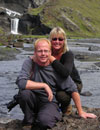Namibia Self Drive
Search For Desert Elephants In Purros
We started our Namibia self drive tour by visiting the breathtaking sand dunes in Sossusvlei. Our self drive Namibia tour was however far from over, because from there we went searching for desert elephants in Purros.
And we found them, or should we say... they found us.
Namibia Self Drive - The Way To Purros
After wonderful time in the Namib Desert, we stayed for few days in Swartkopmund. We used the opportunity to wash all the sand and dust from our belongings (and us) and to restore the food supplies. When on Namibia self drive tour, you must use every opportunity to stock up on food and petrol.
The plan was to drive along the Skeleton Coast on our way to Purros to search for the desert elephants. Some locals convinced us to go to Spitzkoppe instead, as September is not the right time of the year to visit the coast (too cold and foggy).
We did not regret that decision. Spitzkoppe is one of Namibia's most recognizable landmarks. The peaks distinctive shape has earned it its nickname Matterhorn of Africa.
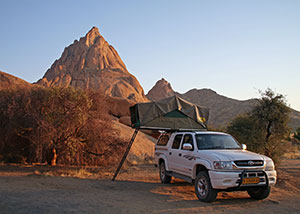
Campsites do not come much better than this
Camping in Namibia is great. All the campsites we visited had all the basic facilities you need, i.e. water, toilet, hot shower. The nicest thing about camping in Namibia is though the scenery. We have never stayed in so many beautiful campsites like in Namibia Africa.
The campsite in Spitzkoppe was the “crème de la crème” for us. We were totally on our own with the most fantastic view of the beautiful peak. At sunset, the whole area turned beautifully red and the full moon casted wonderful light after dark. Just magical.
We spent the following day exploring the area, including hiking and climbing to the Bushman Paradise, a cave containing some of the finest collections of rock art in Namibia Africa.
We then continued our Namibia self drive tour to Purros, stopping on the way in Twyfontein, which is famous for its rock paintings and engravings. Over 2,500 engravings have been identified in the area, the oldest from around 300 BC (the youngest as recent as the 19th century).
We also stopped on the way to view the Organ Pipes and Petrified Forest, i.e. over 250 million years old trees that have turned into stones. Simply magnificent.
We ended in another lovely campsite in Warmquelle but on the way there, we almost drove into a herd of giraffes... on the main road, yet another first one.
Namibia Self Drive Top Travel Tips
Namibia self drive tours are quite popular since Namibia is relatively safe African country to travel to and the roads are relatively good. There are many car rental companies and the standard of accommodation is good in the big cities. Travelling out of town however requires advance planning.
4x4 SUV's and Camper vans are popular choice for Namibia self drive tour. We rented 4x4 SUV pickup equipped with a tent on the roof and we loved this travel mode. It gave us the freedom we needed, and is a very comfortable way of travelling. Getting ready for the night was quick and easy, as was packing up every morning. Highly recommended for those considering Namibia self drive.
Hiring a motor home on the other hand is less practical for Namibia self drive tour since many of the country roads are very rough and many of these vehicles do not have good ground clearance.
Our First Sighting Of Desert Elephants
The following day we continued our Namibia self drive tour and headed to the small remote town of Purros. The road was pretty bad so it took us over 3 hours to drive the 100 kilometers.
Again, the campsite was great. We got our own big tree to camp under and had our own “en-suite”, i.e. toilet and shower - tucked away in a bush under open air. It was actually very clever how they sorted out the showers.
The water for the shower is heated by burning few tree logs that are placed at the bottom of a cut out gas cylinder. The inside of the cylinder has been fitted with water pipe running through it in a spiral. The water then picks up the heat from the fire on its way up through the cylinder.
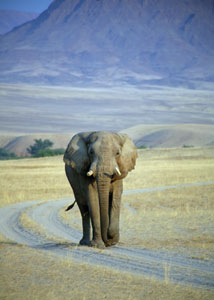
The amazing desert elephants
in Purros Namibia
The temperature of the water is perfect, and you actually have a mixer tab in case the water gets too hot. Brilliant solution!
We hired local guide to help us search for our desert elephants. We found two male elephants very quickly. They were simply walking on the road just in front of us until they found a tree and started eating.
They are careful not to destroy the trees, i.e. they only eat relatively small amount of each tree in order to preserve their food supplies.
Desert elephants are different to other African elephants. They require less water per day (only 150 liters compared to the normal 250 liters) and have longer legs and slender body.
They can go without water for 3 days, which other elephants cannot do. This is how they can survive in this dry and harsh environment.
Visit To A Himba Village
After following and watching the elephants for a while our guide took us to visit a small Himba village. The Himba people are an ethnic group that lives in northern part of Namibia. They live in small family units, 20-30 people, and breed cattle and goats.
Traditional Himba people wear little clothes. Both sexes wear loincloths made of animal skins and are topless.
It is however the Himba women that catch the eye. They cover themselves in specially made red mud called otjize (mixture of butterfat, ash and ochre) to protect their skin from the sun.
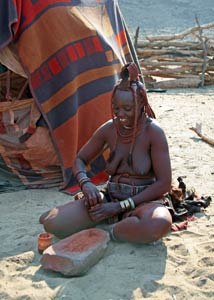
Beautiful graceful
and colorful Himba women
It gives them a very distinctive reddish color, as well as distinctive smell. But it protects their skin very well from the damage of the sun.
Their hair is beautifully braided and covered in the otjize as well. They wear lot of jewelries, including beaded anklets to protect their legs from venomous animal bites.
The outcome is spectacular and they look very beautiful and graceful in their traditional Himba costumes.
Another thing you will notice is the lack of the four front lower jaw teeth. The teeth are literally knocked out in a special ceremony when Himba children reach the age of 10 and 12 years old.
It was interesting to visit this Himba village and learn how they have lived in this harsh environment over the years. Their culture is though slowly changing like everywhere else in the world.
Close Encounter With Desert Elephants
Maybe Bit Too Close
After visiting the Himba village, we continued our search for desert elephants on our own. We found a small herd of elephants and watched them for a while from a safe distance.
After good day out, we headed back to our campsite in the late afternoon. Then we almost bumped into the two male elephants we had seen in the morning. They were eating their way through the riverbed and were now ON the road to our campsite, blocking the main entrance. We had to wait for almost an hour until it was safe to pass them.
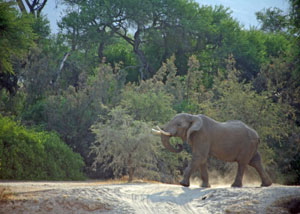
The desert elephants visiting our campsite
We started preparing dinner, BBQ, as proper when camping in Namibia. We could hear our new friends in the distance while doing so - they had started eating their way through our campsite.
Then we saw them, eating the tree at campsite number 3, then campsite number 4, heading towards campsite number 5... where we were staying. And it was getting dark.
We did not know what we should do - we blamed our educational system for not teaching you what to do if wild elephants are going to eat your campsite.
We remembered reading somewhere that if you claim your space, they will move on. For some reason, making loud noises and trying to look bigger in front of two huge hungry wild elephants in the dark, didn't appeal too strongly to us at the time.
We therefore retreated into our car (without eating) while they ate their way through our camp. The thing about elephants is that they move about silently, the only thing we could hear was when they broke off tree branches to eat.
Then we heard dump dump sound, like drums in the distance... Asa explained to Birgir that this was the sound people were making from the nearby village, used to scare the elephants away. The dump sound was then followed by a waterfall sound and smell... then we realized what the drumming had been!
We sat silently in the dark for over an hour. Then we hadn't heard anything for a while so Birgir decided to turn on the car's headlight. Just seconds before he did, Asa noticed an elephant standing just few feet away in front of the car. She just managed to stop Birgir from turning on the lights in time. Not sure, the elephant would have appreciated being blinded by our light!
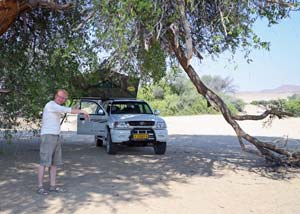
Birgir showing where the elephant was,
maybe bit too close for comfort
We stayed in the car for another half an hour. By then, the moon was out and we could see that our friends had moved on to campsite number 6.
So we finished cooking our dinner (the potatoes were very crisp by now) and managed to eat it around 11 pm.
The following morning we investigated the scene and realized they had been just couple of meters away from us when closest. They had enjoyed some of the trees that formed our toilet and shower facility, but left enough behind to ensure privacy for us.
We thoroughly enjoyed our close encounter with the desert elephants in Purros Namibia... especially afterwards.
Namibia Self Drive Travel Tips
Namibia Africa is great country for self drive tours but there are few things worth having in mind. Firstly, beside the main roads, most roads are gravel roads and they can be slippery so drive carefully, especially if you are not used to gravel roads.
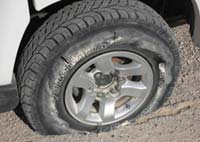
Tire damaged beyond repair
Secondly, there can be animals on the road and they can be very big. We almost drove into a giraffe in one bend. We also spotted an elephant once close to a busy road.
Finally, punctured tires is very common when on Namibia self drive (the gravel is very sharp).
Try to get damaged tire included in the car rental insurance. We were lucky, we only had one puncture during the whole three weeks, but the tire was completely destroyed. Our Namibia self drive vehicle insurance did cover it though.
Have You Been To Namibia / Africa?
Maybe you have been on Namibia self drive, or visited this wonderful country by some other means. Then please tell us about it, just use the form below (see enter the title for your story here). We love good travel stories like most people that enjoy travelling.
Ps. if you liked our Namibia self drive story and photos, why not check out our Laos Self Drive Adventure... on a small motorbike.
Advertisment


